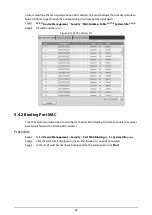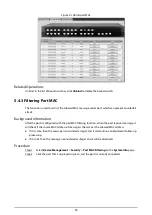
39
receivers.
IGMP Snooping can only forward the information to the needed receivers through layer two
multicast with the following advantages:
●
Reduce broadcast message in the layer two network, and save network bandwidth;
●
Enhance security of multicast information;
●
Bring convenience for realizing individual billing for each host.
5.7.2 Configuring IGMP Snooping
Step 1
Select
Device Management
>
IGMP Snooping
on the
System Info
page.
Step 2
Configure IGMP Snooping.
●
IGMP Snooping
: Enable or disable IGMP Snooping function.
●
IGMP Leave Packet
: Enable or disable the function of quick leave.
Figure 4-26 IGMP Snooping configuration
Step 3
Click
Save
.
5.8 Configuring HTTPS
HTTP (Hyper Text Transfer Protocol) defines how the browser (the World Wide Web client process)
requests a World Wide Web document from the World Wide Web server, and how the server
transmits the document to the browser. From a hierarchical point of view, HTTP is a transaction-
oriented application layer protocol, which is an important basis for reliable exchange of files
(including text, audio, image and other multimedia files) on the World Wide Web.
HTTPS is an HTTP channel with security as the goal. The SSL layer/TLS layer is added to HTTP. The
security foundation to be the HTTPS is SSL/TLS, so SSL/TLS is required for the details of encryption. It
is a URI scheme (abstract identifier system), the syntax is similar to the http: system. It is used to
ensure the secure transmission of HTTP data. The system is built into the browser Netscape
Navigator and provides authentication and encrypted communication methods. It is now widely
used in security-sensitive communications on the World Wide Web, such as protecting account
security and protecting user information.
●
If you configure HTTPS for the first time or change the Switch IP, you need to create server



























